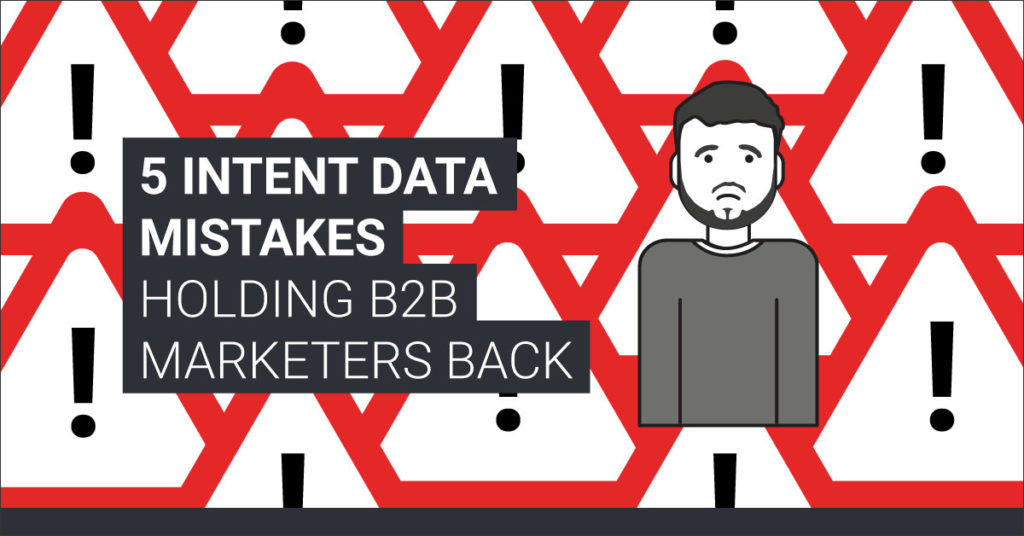Gone are the days of mass email blasts and broad segmentation techniques. In order to engage your audience, it’s vital to send the right message to the right people at the right time. In order to do this successfully, data needs to be at the heart of every demand generation campaign.
But so many B2B marketers are only scratching the surface with predictive-driven sales and marketing. If you want to take your demand gen and lead gen efforts to the next level with intent signals, it’s vital to use data in the right way. Here are 5 common mistakes to avoid if you want to have campaign success.
1. Not sharing insights with your company
Our latest research highlights that 56% of B2B marketers struggle to ensure that their Sales teams utilize insights from intent data.
Whilst B2B intent data is incredibly useful for marketers, in that they can use it across a broad range of channels to personalize the user experience, intent data is also highly valuably outside of the marketing team – in particular, with Sales.
Though Sales and Marketing have notoriously operated in silos, doing so can be detrimental to lead nurture. When Sales reach out to prospects and customers, having full visibility of the customer journey, their interests and challenges is fundamental to having a high-quality conversation, and being able to provide a solution to their problem.
And when it comes to account list segmentation and targeting, it’s vital that these departments collaborate seamlessly. If implementing an account-based marketing strategy across both Sales and Marketing, companies are at risk of missing key communications with contacts, potentially delivering a disjointed journey to the individual. Communicating insights gathered between the two teams will tie the journey together and enable both Marketing and Sales to deliver stronger, united messaging.
For further guidance on lead nurturing and team alignment, check out our eBook ‘Demand Generation Masterclass: How to Follow Up MQLs‘.
2. Misunderstanding the value of third-party intent data
Research shows that 45% of companies use just one source of intent data – either first-party or third-party. By solely focusing on one or the other, B2B marketers are missing out on the value that comes with a combined approach.
And of the 55% that do use a combined approach, 75% are relying on first-party data more than third-party data. What opportunities are being missed?
It can be all too easy focusing on existing customers, especially if data indicates a surging account. But as well as mapping the movements of existing leads, third-party intent data enables you to reach new audiences that haven’t heard about you yet. A combination will guarantee that you are nurturing your customers and leads effectively, whilst continuing to bring in new prospects that could fly through the funnel.
It’s important to use intent data to create awareness, just as much as it is to nurture. Right this second, a potential customer is researching products and solutions just like yours – they’re just not doing it on your website. With third-party data, you can monitor research spikes and trends within your industry, and tailor your content to solve pain points and drive demand. Most importantly, you’re letting new audiences know that you exist.
3. Gathering insights, but not actioning on them
64% of B2B marketers gather intent data, but struggle to action on the insights gathered. This was the biggest challenge marketers faced when asked in our recent survey – and is also the most critical mistake marketers are making.
The sole purpose of gathering intent data is to drive it into decision-making across different areas of marketing. Most marketers, according to research, use intent data to build or develop buyer personas, identify early buyer interest, and prioritize specific accounts or prospects. Actioning on insights is fundamental and makes the process of gathering intent data worthwhile. To source the information, but not use it, is a waste of time.
This is why it is key that marketers plan intent data into their overall demand generation strategy, clarifying what they are looking to achieve when sourcing intent data. Our step-by-step guide will walk you through the process, or our handy checklist can help you leverage intent data across all your suitable channels.
4. Not putting enough budget into gathering and using intent data
Having true visibility comes at a cost. According to our 200 B2B marketers, this cost is between 25-75% of the overall marketing budget – however, when questioned, the majority of marketers also felt that they needed to increase spend next year.
Firstly, this highlights the value of intent data. Only 24% of those questioned used under 25% of their overall marketing budget on intent data, yet 67% wanted to increase spend, suggesting that the recommended budget would be 50% or more. With benefits such as improved personalization and lead nurture strategies, more accurate predictive targeting and the ability to reach leads earlier in the buyer journey, it’s clear to see why marketers would want to spend more.
Secondly, this could potentially indicate the need to invest in more tools to gather first-party intent data, as well as to invest in more third-party intent data options. Web analytics software, customer relationship management systems, email marketing platforms and marketing automation tools will all provide first-party insights – and all come at a cost.
Similarly, third-party sources will add a new element to your intent data strategy, but also require further budget. Allocating enough resource to gather intent data will benefit your strategy, with 55% of B2B marketers agreeing that a combined approach is the most successful way to handle intent data.
5. Only using intent data at the bottom of the funnel
It’s no news flash that prospects do not move through the marketing funnel in a linear fashion. In fact, it’s much more complex than marketers first thought when the funnel concept was invented. However, that doesn’t mean we can’t map a prospect’s movements along their journey to see what they’re going to do next.
Buyers want to connect with brands across a range of touchpoints. Therefore, having a comprehensive approach to content is vital. This means investing time and effort into various channels, and delivering content on the platforms that audiences actually want to use.
According to our 200 B2B marketing leaders, the best channels for using intent data include email marketing and nurture workflows (72%), video advertising (70%), paid social media (69%) and programmatic display (54%).
Don’t just focus on the leads at the bottom either. Prospects will likely dip in and out of the funnel, so maintaining a connection with demand generation or lead nurture campaigns is every marketer’s priority. And by tapping into multiple channels and taking a birds eye view of the funnel, you can begin to better understand buyer intent.
Another benefit reported by our survey respondents was “reaching leads earlier in the buyer journey”. This is key for demand generation, as it allows marketers to get their brand, product or service in front of the right crowds. By creating better brand awareness early on, you can gain a competitive edge over other similar providers. This also gives sales teams the option to begin lead nurturing, and by collecting intent data from inception, campaigns and content can be tailored more effectively later on.






